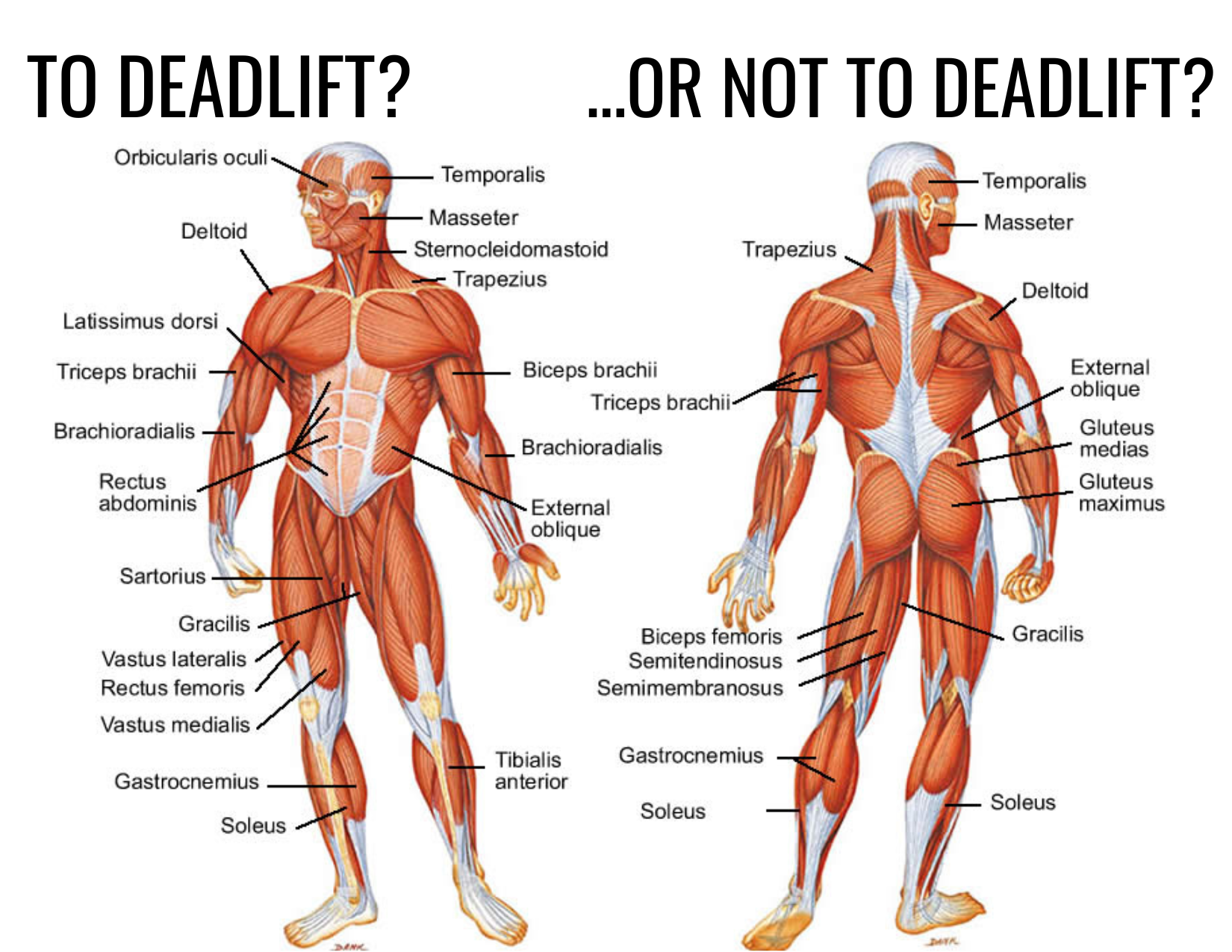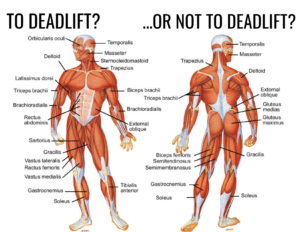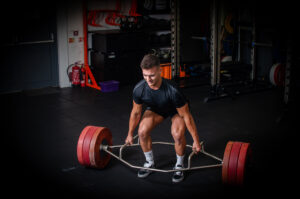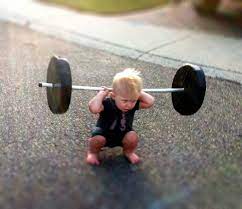
09 Dec 5 Reasons Why You Should Deadlift
When someone says it’s deadlift day…
Recently, I was asked “What is the absolute best exercise?”. At first I laughed it off, as there are literally infinite possibilities of exercise, but then I thought about it as if I had to pick one, and I landed on the deadlift. But I realize that a lot of people either hate to deadlift, or they are scared to because of bad experiences with low back pain (I was one of those people). The truth is that when done correctly, a deadlift will produce benefits that far outweigh the risks. And like any other exercise, there are risks. However, a hinge movement is much more natural when compared to other loaded compound movements such as a squat.
Now I’m not seriously going to try and convince you that a deadlift is the greatest exercise of all time, but I am going to lay out 5 reasons as to why it is an overall slam dunk. Followed by some helpful tips on how to figure out which variation is the best for you to perform.
#1 Deadlifting is a Full Body Exercise

Posterior Chain
Picking up weight off of the floor (especially a lot of weight) is a whole body effort. The most significant area is the entire posterior chain, all the muscles of your back side. This is especially important for anyone who spends time sitting. When we sit our posterior muscles are lengthened and relaxed, training them in the hinge pattern pulls out the inner runway model hiding inside all of our slumped posture.
The Core
It’s a great core exercise, and not just the 6-pack, but the whole package. By creating tension and stabilizing, the core muscles allow us to transfer energy from the bar to our legs as we pull the weight from the floor.
Read our last blog post for more on how to train your core.
Grip strength
Just holding heavy weights in your hands will help develop grip strength. Which is not only good for opening pickle jars, but gripping comes with rotator cuff activation and shoulder stability. A strong grip, much like strong legs, is associated with longevity.
#2 Carry Over Into Athletic Performance


Practice How You Play
Take notice of the deadlift shape, most athletic positions start in a similar hinge shape. I can’t think of too many sports that involve lying on a bench and throwing a weight off of your chest.
But aside from relative positioning, there is also an aspect of force development. A deadlift is a closed chain exercise where you are applying force into the floor, meaning that you have to drive your feet into the floor just the same as during an athletic move. This creates greater carryover compared to other open chain exercises, where your feet are not connected to the ground even if they’re training similar muscle groups.
Still Be Able to Perform
While we’re talking about athletics, the deadlift is a great in-season exercise as it’s mostly a concentric movement. Simply put, if you focus on the pull more than the lowering, there will be little to no soreness the next day. There’s also a great return on investment when it comes to volume. You don’t need to crush a ton of reps in order to get a training effect. Which is important to consider when an athlete is in season, or closing in on an event and the goal is to reduce volume of exercise without sacrificing gains.
#3 Carry Over Into Daily Life


I mentioned before that a deadlift is a natural human movement. If you think about it, how long have humans been picking things up from the floor? Now how long have they been loading up weight on their shoulders and squatting it up and down? Every human should have the ability to pick up their kids, groceries, and other awkward weight both in and outside of the gym.
#4 You Will Improve Your Mobility
Not only are deadlifts a sure fire way to improve overall strength and functional power, but they are a great mobility tool. Learning how to hinge properly, while progressively loading will open up access to the hips and improve toe touch mobility.
The key is that you are progressively loading (strengthening) the hamstrings as opposed to just stretching them. If you feel like you have tight hamstrings and you can’t touch your toes, there are plenty of stretching, mobility, and self myofascial release techniques that will improve your mobility within minutes. You may even get all the way down to your toes. The problem is that without ever actually strengthening this new found range of motion, the “improvements” are transient. As we start to learn how to control and load the hinge pattern, the strength gains allow us to own new ranges of motion that we didn’t have access to before.
#5 It’s Easy to Learn
Because the hinge is such a natural form of movement, there is usually a short learning curve to this type of exercise. That’s not to say that a beginner should be loading up a barbell on day one, but there is a hinge variation for almost anyone.
If you are just learning the deadlift pattern, we can start with either a banded pull through, or a kettlebell deadlift. Both of these exercises are done with a relatively light load making it easier to focus on the movement demands.
Learning The Hinge
Banded Pull Through
- The band resistance acts as a cue for your hips to follow as you descend into the hinge
- Reach the hips back until a light-moderate stretch is felt in the hamstrings, then reverse out of the movement
Kettlebell Deadlift
- This variation assimilates to a loaded deadlift more than the pull through because the load is in front of you
- Decrease the mobility demand by lowering down to a yoga block or a stack of plates
Trap Bar Deadlift
The Benefits:
- Higher handle set up means that less mobility is needed to get down to the bar.
- Comes with the option to progress to the low handle setting for deeper range of motion
- There is less stress on the back because the weight is distributed at your sides, instead of infront of you like a straight bar deadlift.
- Easier to perform for people with longer legs/femurs because the bar does not have to clear the knees like a straight bar would.
What to Look Out For:
- Over extending your back past neutral. Because there is no bar to stop you from over-extending, this is a common mistake made with the trap bar.
- Its easier to squat the weight instead of hinging with it. Stay connected with your heels and hamstrings.
Sumo Deadlift
The Benefits:
- Wider stance means less mobility is needed to get down to the bar compared to a conventional deadlift. It also means the bar will travel a shorter distance overall, less stress on the back.
- Easier for people with longer legs/femurs compared to a conventional set up.
What to Look Out For:
- Narrower grip will tend to round the upper back, widen it up a bit
- Less carry over to athletic performance because of the wider stance.
Conventional Deadlift
The Benefits:
- Provides the most feedback for proper movement. At the top of the lift when you lockout, the bar will stop you from over-extending. On the lowering half, you have to shift your hips back or your knees won’t clear the bar.
What to Look Out For
- This setup requires the most amount of mobility through the hips and ankles. Consider elevating the bar when first starting out.
- Greatest amount of shear stress compared to other variations, the weight is in front of you and the bar has to travel a greater distance.
The Takeaways…
The world’s greatest exercise probably doesn’t exist, but the deadlift checks off a lot of boxes for both athletic and life performance.
Learn the hinge well before you hinge a lot (or with heavy load)
Find the right point of entry for a loaded deadlift, starting with a trap bar or a sumo set up, then working into more conventional forms.
Interested in learning more about how to maximize your movement and overall performance? We offer free 15-minute phone consults, clink the link here to schedule yours or call us directly at 516-421-6353. Contact me directly at [email protected]

